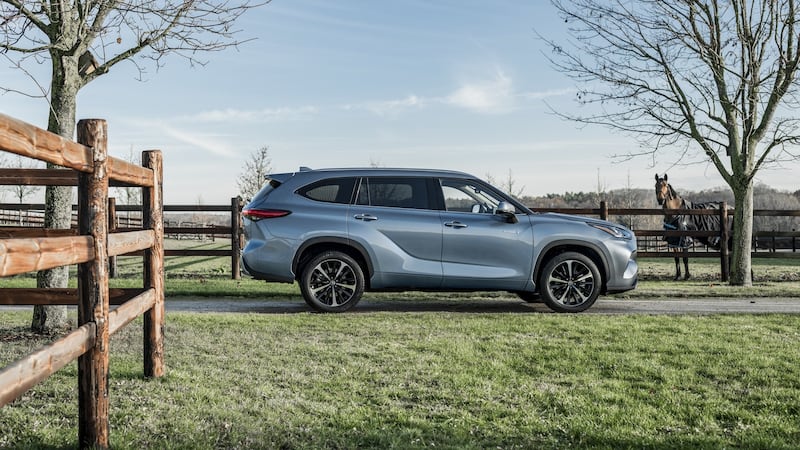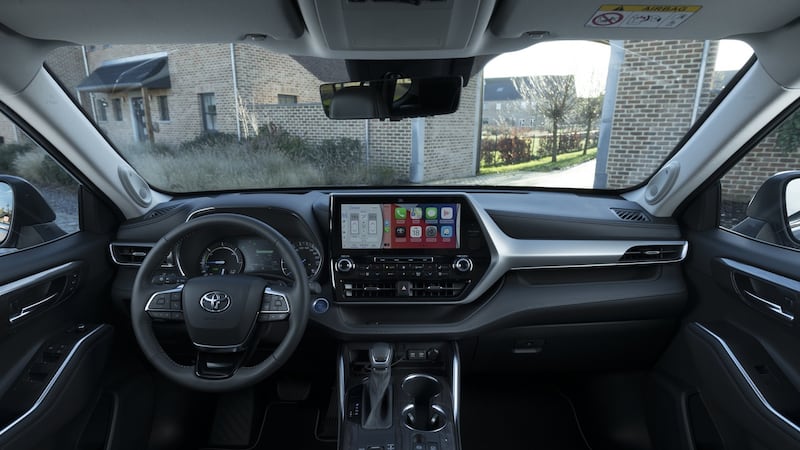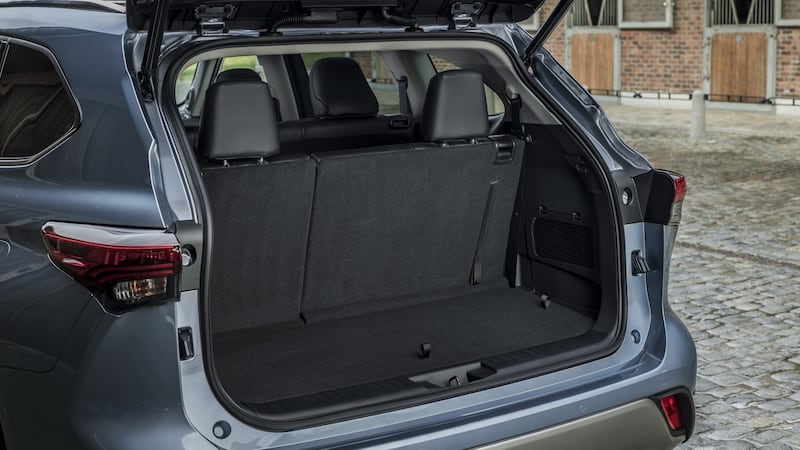A seven-seat SUV with striking good looks, hybrid power and a Toyota badge. It has all the right ingredients for an Irish sales success.
Rivals should be running scared. Toyota is a chameleon brand. One the one hand it has the sensible Yaris, which sits on suburban driveways next to well-maintained beds of dahlias and hyacinths. At the other end is a full-blooded 4x4 off-roader, the Land Cruiser, favoured by folks in war zones, where roads are optional and breaking down can be fatal.
But they left a gap in the market, at least in Europe. Certainly the Rav4 served many family needs, but not those requiring proper seven-seaters. This is where the Koreans reaped rewards at the mainstream end of the market, while premium players like Volvo, with its XC90, established a firm foothold among well-heeled families.

Now in rolls the Highlander, an SUV new to Irish buyers but on the market in America and Asia since 2000.
Essentially what we have here is a larger version of the Rav4, for this is meant to conquer the mean city streets on the school run rather than head up a convoy on a rescue mission in Mali. That said, while it might not have the rough-and-tumble credentials of the legendary Land Cruiser and Hilux, reports from the US suggest strong reliability and owner satisfaction scores.

Data published this month in the US by Consumer Reports ranks the Highlander among the top performers of the Toyota range and also against equivalent rivals available here. With an overall score of 84, it is better than Rav4, with 79, and the Land Cruiser, with 74. The Report scores the Volvo XC90 at 62 for and gives 45 for the Land Rover Discovery. While that's just one organisation's view, it does leave us with the takeaway that the Highlander is well regarded across the Atlantic.
So what’s to like? Well, there are certainly its looks, which gives the Highlander a lot of the same muscular design as its larger Land Cruiser sibling. Perhaps the one signal that it has closer links to the Rav4 is around the back, where the rear bears a lot similarities to that model.

Inside the cabin has been properly attired for family life, big comfy seats and excellent seating position for road visibility. There’s all the legroom you might need, and decent access to the third-row, not something that’s always a feature in these cars. You still have to climb up into the car, but you don’t need to dive head-first over the second row seats to get into the very back. There, the position of the seat cushion allows for legroom without forcing your knees up to chest height.
Even with seven seats in play, you get a more than reasonable supermini sized boot of 241 litres. Switch to five-seater mode and you get an impressive 658 litres – better than most family estate cars. Drop the second row down and it grows to a stadium-like 1,909 litres.
The cabin itself is strong on build quality, if lacking some of the pizazz of rivals when it comes to tech. Toyota is still playing it very conservatively when it comes to abandoning buttons and there is a lot of shared switchgear from lower-priced models like the Corolla, which might not please someone paying €60,000-plus.
Power comes from the 2.5-litre petrol engine combined with an electric motors powered by a nickel metal battery pack delivering 248bhp and 239Nm of torque. And it’s no slouch, delivering a 0-100km/h time of 8.3 seconds, which is very impressive for a hybrid of this size.
The interchange between electric motor and petrol engine is smooth – more like a Lexus than a Toyota Prius. Driving dynamics are not something that will concern many owners, but the steering does feel more controlled than with Korean rivals, while there are no issues with the ride and comfort.
The burning question is why this car is not offered as a plug-in hybrid, but Toyota makes the case that regular hybrid is more efficient for longer journeys and the Highlander is the sort of car that will be doing higher mileage.
And it’s on those sort of drives that diesel used to reign supreme. Looking at the fuel economy, the Highlander does deliver a respectable figure of 6.6 l/100km (42.8 mpg), and in real-life driving we got very close to that figure across a wide mix of driving, from short hops to motorway driving.
Under the new WLTP rules every gram of CO2 counts, so by opting for the top grade Platinum trim, which thereby adds weight, the official fuel consumption figure rises from 6.6 l/100km to 7.1 l/100km. It also adds €10 a year in motor tax. For someone spending over €60,000 on a new car, that’s unlikely to be a deal breaker.
For many well-heeled family buyers, the big Toyotas are rightly regarded as premium buys
So finally Toyota has filled a big gap in its range and given the relative shortage of seven-seaters on the market – and the brand’s loyal family following – success should be assured.
What could undo the Highlander is a surprising Korean that came over the horizon relatively unnoticed: the big Sorento plug-in hybrid. We could start throwing fuel economy stats at this debate and fill out a few graphs and pie charts, but there is one figure that will stop most debates in its tracks: €19,995.
That's the price difference between the top of the range Toyota Highlander and the top Kia Sorento Plug-in hybrid. At entry level for both cars the Korean comes in at €14,000 less than its Japanese rival. Those are sums not be sneezed at, even if you do longer daily trips than the 50km or so that Kia reckons its car will run on full electric.
Toyota comes back with promises of brand strength and build quality. Perhaps both are true, but to the extent that they warrant that sort of price gap, I’m not so sure.
In some ways it depends upon which angle you are looking at the Highlander.
Looking from the premium market, the landscape look a lot brighter for the Highlander. Pit it against the premium models of a similar scale and the price gap are just as great as that between it and the Sorento. The Volvo XC90 starts at €82,420, with prices rising higher for the seven-seat versions of the Land Rover Discovery and the Lexus RX450L.
And for many well-heeled family buyers, the big Toyotas are rightly regarded as premium buys. A Land Cruiser is a fixture in my fictional Lotto garage, just as it is in the every wealthy household in the Middle East and Africa. Where the land is rugged and the climate tough, you will regularly see gleaming white Toyotas sitting alongside Rolls-Royces and Lamborghinis. In sunny climes with shady people, it won't be the Lambo they jump into when things turn nasty.
So if you are approaching it from the premium ranks, the Highlander seems like reasonable value, though you may not find the interior as high-tech as those of rivals. For those on a tighter budget, it may seem the new plug-in hybrid Kia Sorento may have stolen its thunder.
Lowdown: Toyota Highlander Hybrid Platinum
Power: 2.5-litre petrol engine combeined with nickel metal battery pack delivering 248bhp and 239Nm of torque
L/100km (mpg): 7.1 (39.8)
Emissions: 159 g/km (€280)
0-100km/h: 8.3 seconds
Price: €74,995 as tested (starts at €63,995)
Verdict: Top class seven-seater that should have landed sooner, but is now undone by a Korean rival










